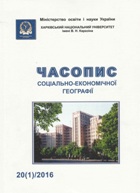Confessional space and its structure in the context of human geography research
Abstract
On the basis of analysis of the works of many scientists, we concluded that the confessional space is different from the concepts of confession, religious sphere and religious space. They all have different scientific explanation and interpretation, although sometimes they have been used as synonyms in Ukrainian social geography. Confessional space differs from religious space, primarily in the fact, that it does not include atheists, agnostics and others, who do not associate themselves with any beliefs.
Confessional space – is a part of the religious space that combines in a particular area religious communities, movements and trends that are interconnected with each other by different types and forms of relationships.
This our understanding of the confessional space allows us to form different types of structures, namely: territorial, branch (interior, confessional) and management, because it reflects the territorial and branch connection. We present the territorial structure by such elements as: confessional point, confessional center, confessional area and confessional node. We propose to allocate confessional and geographical regions and subregions by the confessional and geographical regionalization. The branch (internal, confessional) structure of the confessional space ofUkraineis represented by more than 55 different trends, confessions and movements. The management structure is rather complex, as every religious confession has its own characteristics in management. It has been established, that the confessional space plays an important role in shaping of the public thinking and course of many social processes.
Downloads
References
2. Guseynov, G.Ch. (2002). Prostranstvo. Otechestvennye zapiski, 6, 35-39.
3. Maslyak, P.O., Oliynyk, Ya.B., Stepanenko, A.V. (1996). Slovnyk-dovidnyk uchnya z ekonomichnoi i sotsialnoi geografii svitu. Kyiv: Libra, 328.
4. Gorina, K.V. (2011). Geograficheskaya spetsifika formirovaniya konfessionalnogo prostranstva Zabaykalskogo kraya: avtoref. diss. na soiskanie uchenoy stepeni kand. geogr. nauk: 25.00.24 «Ekonomicheskaya, sotsialnaya, politicheskaya i rekreatsionnaya geografiya». Ulan-Ude, 23.
5. Filimonova, I.Yu. (2006). Struktura i razvitie konfessionalnogo prostranstva Orenburgskoy oblasti: diss. na soiskanie uchenoy stepeni kand. geogr. nauk: 25.00.24 «Ekonomicheskaya, sotsialnaya, politicheskaya i rekreatsionnaya geografiya». Orenburg, 174.
6. Muzalyov, A.A. (2007). K voprosu o geografii religiy i o ponyatii «religioznaya geosistema» v geograficheskom issledovanii. Vestnik Adygeyskogo gosudarstvennogo universiteta, 1, 159-161.
7. Safronov, S.G. (1998). Geograficheskie aspekty izucheniya religioznoy sfery Rossii: avtoref. diss. na soiskanie uchenoy stepeni kand. geogr. nauk: 25.00.24 «Ekonomicheskaya, sotsialnaya, politicheskaya i rekreatsionnaya geografiya». Moskva, 23.
8. Andreyanova, S.I. (2015). Struktura i osobennosti formirovaniya konfessialnogo prostranstva Severnogo Kavkaza: diss. na soiskanie uchenoy stepeni kand. geogr. nauk: 25.00.24 «Ekonomicheskaya, sotsialnaya, politicheskaya i rekreatsionnaya geografiya». Stavropol, 133.
9. Bulaev, V.M., Gorina, K.V. (2011). Konfessialnoe prostranstvo kak predmet sotsialnoy geografii. Vestnik Rossiyskogo gosudarstvennogo universiteta im. I. Kanta, 1, 147-156.
10. Balabajkana, O.A. (2005). Sankt-Peterburgskaya eparkhiya: istoricheskaya geografiya pravoslaviya: : avtoref. diss. na soiskanie uchenoy stepeni kand. geogr. nauk: 25.00.24 «Ekonomicheskaya, sotsialnaya, politicheskaya i rekreatsionnaya geografiya». Sankt-Peterburg, 19.
11. Kostashchuk, I.I. (2011). Terytorialna organizatsiya religiynoi sfery regioniv Ukrainy. Uchenye zapiski Tavricheskoho natsionalnogo universiteta im. V.I. Vernadskogo. Nauchnyi zhurnal. Seriya «Geografiya». Simferopol: Tavricheskiy nats. un-t im. V.I. Vernadskogo, 24(63), 2, 137-143.




